
Israel
by Troy Herrick
Almost two thousand years ago, the world was changed forever by the death and resurrection of Jesus. With the spread of Christianity, countless pilgrims have visited Jerusalem over the ages to renew their faith at the holy sites associated with his last days. Visitors today might be under the impression that these locations are unique and firmly established but this is not necessarily true. In fact, the Temple Mount is likely the only site linked with Jesus’ final days that can be firmly established.
While the four Canonical Gospels provide specific places for the events associated with Jesus’ passion, they do not provide locations that can be confirmed by archaeology. Tradition has largely established the holy spots in and around the Old City of Jerusalem. These have often been altered over the generations, destroyed in long ago wars or buried under churches. The real challenge you face is putting these sites into their proper context as they no longer look the way they did during the time of Jesus. This can really strain your imagination.
Professional tours through the Old City are a relatively recent development. These tours are often prohibitively expensive with limited time available at each location. Alternatively you can take the two-day “do-it-yourself” tour outlined below. You will not visit the sites in the same order as outlined in the scriptures but you will have more time for contemplation at each one. Your costs are limited to the price of admission to two optional sites (the Treasures of the Temple Museum and the Citadel). These have been included to enhance your Biblical experience but your pilgrimage of faith will not be diminished in any way if you choose to pass on them.
DAY ONE
Church of the Dominus Flevit
 Jesus’ triumphal entry into Jerusalem on a colt fulfilled the prophecy of Zechariah (Zechariah 9:9). As he descended the Mount of Olives, he stopped and looked out over the city. Jesus wept upon seeing the Holy Temple across the Kidron Valley (Luke 19:41-44) because he knew that Jerusalem would be destroyed – and it came to pass in 70 CE. This event is commemorated half way down the Mount of Olives where you find the “tear drop”-shaped Church of the Dominus Flevit (Latin for “the Lord Wept”).
Jesus’ triumphal entry into Jerusalem on a colt fulfilled the prophecy of Zechariah (Zechariah 9:9). As he descended the Mount of Olives, he stopped and looked out over the city. Jesus wept upon seeing the Holy Temple across the Kidron Valley (Luke 19:41-44) because he knew that Jerusalem would be destroyed – and it came to pass in 70 CE. This event is commemorated half way down the Mount of Olives where you find the “tear drop”-shaped Church of the Dominus Flevit (Latin for “the Lord Wept”).
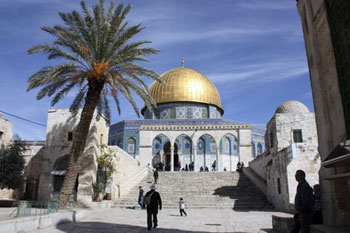 Entering the church, your eyes are immediately drawn to the arch-shaped picture window behind the altar. Those attending mass might be forgiven (hopefully) for being distracted by the magnificent view of the Old City of Jerusalem set within the window frame. The Dome of the Rock and the Church of the Holy Sepulchre are both conspicuous in this picture.
Entering the church, your eyes are immediately drawn to the arch-shaped picture window behind the altar. Those attending mass might be forgiven (hopefully) for being distracted by the magnificent view of the Old City of Jerusalem set within the window frame. The Dome of the Rock and the Church of the Holy Sepulchre are both conspicuous in this picture.
The present-day church is set upon the ruins of a 5th century Byzantine Monastery. Traces of this former complex have been incorporated into the present-day structure. These include a mosaic depicting fruit, leaves, fish and flowers just inside the main entrance and the top slab of an ancient altar near the back of the church. When you complete your visit, exit the church and walk downhill to the Garden of Gethsemane and the Basilica of the Agony.
The Garden of Gethsemane
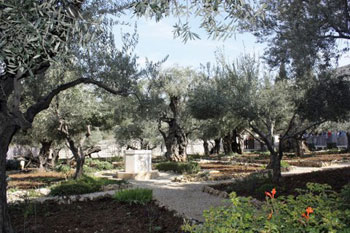 Before he was betrayed, Jesus visited the Garden of Gethsemane to pray (Matthew 26:30, Mark 14:32, Luke 22:12, John 13:1). Located at the foot of the Mount of Olives, the Garden of Gethsemane showcases the Basilica of the Agony with its mosaic façade depicting Jesus as the mediator between God and man.
Before he was betrayed, Jesus visited the Garden of Gethsemane to pray (Matthew 26:30, Mark 14:32, Luke 22:12, John 13:1). Located at the foot of the Mount of Olives, the Garden of Gethsemane showcases the Basilica of the Agony with its mosaic façade depicting Jesus as the mediator between God and man.
Entering the grounds, you are surrounded by gnarled olive trees that are hundreds of years old. While you might wish to believe that these trees date to the time of Jesus, this is unlikely. The Romans cut down all the trees in the area during the siege of Jerusalem in 70 CE.
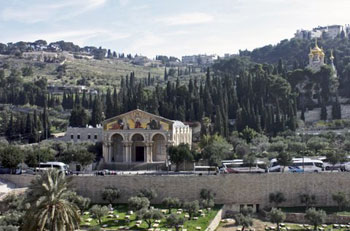 Inside the basilica, dark alabaster windows set the sombre mood for the agony and betrayal of Jesus. The flat “Stone of Agony” near the altar marks the spot where Jesus sweated blood (Luke 22:44) as he prayed. A mosaic behind the altar preserves that moment in time.
Inside the basilica, dark alabaster windows set the sombre mood for the agony and betrayal of Jesus. The flat “Stone of Agony” near the altar marks the spot where Jesus sweated blood (Luke 22:44) as he prayed. A mosaic behind the altar preserves that moment in time.
When you finish your visit to the basilica, walk down to the Old City and pass through St. Stephen’s Gate into the Muslim Quarter where you find yourself on the Via Dolorosa. The former site of the Praetorium is your first stop.
The Praetorium
Jesus was taken from the House of Caiaphas to Pontius Pilate at the Praetorium (Matthew 27:11, Mark 15:1, Luke 23:1, John 18:29). Traditionally the Antonia Fortress is accepted as the Praetorium but it was destroyed by the Romans in 70 CE. The Al-Omariya School for Boys now occupies the former site of this fortress. The cobblestone courtyard of the school is the first of fourteen Stations of the Cross on the Via Dolorosa.
 Also on the site of the original Antonia Fortress, the Franciscan Monastery is located opposite the Al-Omariya School on the Via Dolorosa. This monastery houses both the Church of the Flagellation and Church of the Condemnation (the 2nd Station of the Cross).
Also on the site of the original Antonia Fortress, the Franciscan Monastery is located opposite the Al-Omariya School on the Via Dolorosa. This monastery houses both the Church of the Flagellation and Church of the Condemnation (the 2nd Station of the Cross).
The Church of the Flagellation marks the site where Jesus was flogged (Matthew 27:26, John 19:1). Inside you find stained glass windows depicting Christ being whipped and Pontius Pilate washing his hands of the whole affair. The dome above you incorporates a crown of thorns in mosaic form.
The Church of Condemnation is the traditional site where Jesus received his cross and was led away to his crucifixion (Matthew 27:31, Mark 15:20, Luke 23:25, John 19:16). Behind the altar you find a diorama depicting the moment of condemnation.
This church is set upon a Roman flagstone road called the “lithostatos” (John 19:13). The lithostratos upon which you are standing is from the time of the Roman Emperor Hadrian, almost a century after Christ. As such this site unlikely hosted any of the Biblical events associated with the last days of Jesus.
Recent archaeological evidence suggests that the Praetorium was actually Herod’s Palace, now part of the Citadel, near the Jaffa Gate. You can tour the Citadel and see wall sections dating to the time of Jesus. This tour is best left until the end of Day 2.
Continue down the Via Dolorosa to the Church of the Holy Sepulchre. A number of events associated with the various Stations of the Cross either did not appear in the scriptures or they did not occur at identifiable locations. As such they are not included here but that should not deter you from visiting them anyway. En route you may also wish to shop for that perfect souvenir as you will be passing through the marketplace (souk).
The Church of the Holy Sepulchre
 The Church of the Holy Sepulchre, the holiest site in Christendom, is the traditional site of the crucifixion and tomb of Jesus. Enter the church and climb the well-worn stairs immediately to your right to the top of Golgotha/Calvary (Matthew 23:35, Mark 15:22, Luke 23:33, John 19:17). Here you enter the Roman Catholic Chapel of the Nailing of the Cross – the 11th Station of the Cross.
The Church of the Holy Sepulchre, the holiest site in Christendom, is the traditional site of the crucifixion and tomb of Jesus. Enter the church and climb the well-worn stairs immediately to your right to the top of Golgotha/Calvary (Matthew 23:35, Mark 15:22, Luke 23:33, John 19:17). Here you enter the Roman Catholic Chapel of the Nailing of the Cross – the 11th Station of the Cross.
The adjacent Greek Orthodox Chapel showcases the rock of Calvary set behind glass under the altar – the 12th Station. Also visible under the altar is a star with a hole in the center marking the spot where Jesus died on the cross (Matthew 27:50, Mark 15:37, Luke 23:46, John 19:30). Feel free to extend your hand down into the hole when you reach the front of the line.
Descend the stairs and walk over to the Edicule which is the structure, supported by a dark metal frame on the exterior, preserving the location of Christ’s tomb (Matthew 27:60, Mark 15:46, Luke 23:53, John 19:41-42). Tradition holds that the Roman Emperor Constantine had the rock face of Golgotha cut away from around the tomb leaving only a stone shell. This shell was levelled in 1009 CE on the orders of the “mad” Caliph Al-Hakim. The next structure to occupy this space was the current Edicule, constructed in the 19th century.
 Join the line to enter the Chapel of the Holy Sepulchre inside the Edicule – the 14th Station of the Cross. Inside you find a reconstructed slab on your right consisting of two marble stones. A vase with candles marks the spot where Jesus’ head once rested.
Join the line to enter the Chapel of the Holy Sepulchre inside the Edicule – the 14th Station of the Cross. Inside you find a reconstructed slab on your right consisting of two marble stones. A vase with candles marks the spot where Jesus’ head once rested.
If your imagination feels somewhat stretched with your visit the Chapel of the Holy Sepulchre, you may wish to visit the Garden Tomb where many Protestants believe that Jesus was laid to rest. Scripture holds that Jesus was set down in a new tomb (Matthew 27:60, John 19:41); as such this 9th-7th century BCE tomb with 4th – 6th century CE slabs does not fit the Biblical description.
DAY TWO
The Temple Mount
Jesus drove the money lenders from the Temple (Luke 19:45, Matthew 21:12, Mark 11:15) and then taught there over the next several days (Matthew24:1, Mark 11:27, Luke 19:47). A visit to the Temple Mount today requires a great deal of visualization. Nothing from the time of Jesus remains except for the platform and support walls.
The exact location of the holy structure on the platform is the subject of much debate. Tradition holds that the Temple once occupied the same space as the present-day Dome of the Rock. Archeologists have not been able to confirm this because they are not permitted to work on the site. You may gain some insight into the temple structure with a visit to the nearby Treasures of the Temple Museum. Here you find a white marble model of the holy building and reconstructed equipment for use in a third Temple.
The present Temple Mount (also known as Haram ash-Sharif meaning “Noble Sanctuary” in Arabic) holds the Dome of the Rock and the Al Aqsa Mosque. The Dome of the Rock is decorated with colorful Turkish tiles and white marble. The dome is gold leaf set over aluminum. Non-Muslims were not permitted to enter at the time of my visit. A nearby ticket booth suggests that this was not always the case however.
The Al Aqsa Mosque at the southern end of the platform is the third holiest site in Islam after the shrines in Mecca and Medina respectively. The façade of this mosque consists of fourteen stone arches. While entry to the mosque is through the central arch, non-Muslims are not permitted to enter.
When you have completed your visit, exit the Temple Mount and stop by the Western Wall below – the holiest site in Judaism. Men enter this outdoor synagogue on the left side and women on the right. Men should also remember to keep their heads covered if they enter this outdoor synagogue. After leaving the Western Wall, your next stop is the Coenaculum on nearby Mount Zion.
The Coenaculum
The Coenaculum (Latin for “dining room”) is the traditional site of the Last Supper (John 13:1, Luke 22:12, Mark 14:17, Matthew 26:20) and where the Apostles received the Holy Spirit on Pentecost (Acts 1:13, 2:1). Crusaders constructed this room in the 14th century on top of an older base that could date to the time of Jesus. Therefore in reality, the current hall with three naves encloses the space where Jesus celebrated Passover.
The Ottoman Turks took control of the site and transformed it into a mosque. Imagine Leonardo Da Vinci’s fresco of the Last Supper set in this room with limestone pillars, gothic arches and the vestiges of a mosque providing the backdrop. A prayer niche, known as a mihrab, on the wall still serves to direct people toward Mecca; and Arabic script is still visible below one of the windows. Exit using the door to the right of the mihrab and walk to the Church of St. Peter in Gallicantu.
The Church of St. Peter in Gallicantu
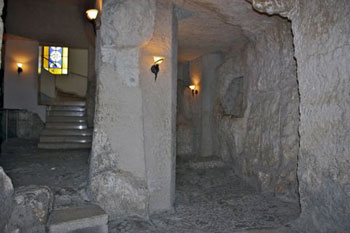 Set on a sheer hillside, the Church of St. Peter in Gallicantu is the traditional the site of the High Priest Caiaphas’ house. Jesus was brought before Caiaphas immediately after his arrest (Luke 22:54, Mark 14:54, John 18:24, Matthew 26:57). You can easily find this church by looking for the roof with a golden rooster set on top of a cross. The rooster identifies this as the site where Peter denied Christ three times before the cock crowed (Matthew 26:69-75, Mark 14:66-72, Luke 22:55-62, John 18:25-27) hence the name “Gallicantu” (Latin for “the cock’s crow”). A statue in the courtyard depicts the event.
Set on a sheer hillside, the Church of St. Peter in Gallicantu is the traditional the site of the High Priest Caiaphas’ house. Jesus was brought before Caiaphas immediately after his arrest (Luke 22:54, Mark 14:54, John 18:24, Matthew 26:57). You can easily find this church by looking for the roof with a golden rooster set on top of a cross. The rooster identifies this as the site where Peter denied Christ three times before the cock crowed (Matthew 26:69-75, Mark 14:66-72, Luke 22:55-62, John 18:25-27) hence the name “Gallicantu” (Latin for “the cock’s crow”). A statue in the courtyard depicts the event.
The church was constructed on top of ancient prison cells hewn into the bedrock and dating to the time of Jesus. Entry was originally facilitated by being lowered down with a rope through a hole in the ceiling. Don’t worry, you can descend in a more dignified fashion by means of the “Holy Stairs”. As a prisoner, Jesus was likely kept here in total darkness while he awaited his trial before Caiaphas. This being the case, it is somewhat surprising to find a peephole for guards to look into the cell.
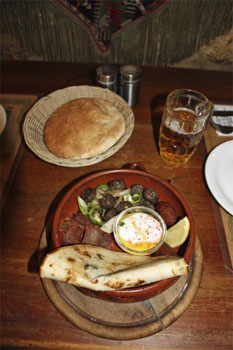 The churchyard features a number of ruins including olive presses, a bath house and a stone stairway leading to the Pool of Silwan below. Jesus may have used this stairway as he walked from the Coenaculum to the Garden of Gethsemane by way of the Kidron Valley before his betrayal. Visitors also find a model of the Old City of Jerusalem during the 4th-6th centuries CE. The Temple Mount is conspicuously bare and remained that way until the Dome of the Rock was constructed in 691 CE after the Muslim conquest.
The churchyard features a number of ruins including olive presses, a bath house and a stone stairway leading to the Pool of Silwan below. Jesus may have used this stairway as he walked from the Coenaculum to the Garden of Gethsemane by way of the Kidron Valley before his betrayal. Visitors also find a model of the Old City of Jerusalem during the 4th-6th centuries CE. The Temple Mount is conspicuously bare and remained that way until the Dome of the Rock was constructed in 691 CE after the Muslim conquest.
This “do-it-yourself” tour concludes here if you choose not to visit the two optional sites. You can return to the Armenian Quarter of the Old City by way of the Zion Gate. If you have worked up an appetite, why not try some Armenian food at the Armenian Tavern. Highly recommended is the Selected Plate that includes a mixed grill consisting of sausage, onion and peppers (Soujouk), followed by a thin garlic sausage (Basturma), a wheat-covered falafel (Kubbeh) and a savory Armenian pizza. The cost was 60 Shekels at the time of my visit.
If You Go:
This tour is best accomplished in two consecutive days from Monday to Thursday. Visitors should remember that Friday, Saturday and Sunday are the Muslim, Jewish and Christian holy days respectively. As such, some of the respective sites may be inaccessible because of religious services on these days. Your tour should be flexible.
You can visit the Tourist Information Office at the Jaffa Gate for maps to each site.
The Basilica of the Agony, also known as the Church of All Nations, and the Garden of Gethsemane are located at the foot of the Mount of Olives. You can’t miss the mosaic on the basilica facade. Admission is free
The Church of the Dominus Flevit is located on the main road for ascending the Mount of Olives. You can find this road behind the Garden of Gethsemane. Admission is free
The site of the Praetorium is about 300 meters west of St. Stephen’s Gate on the Via Dolorosa. Look for the Al-Omariya School for Boys on your left. Admission to the courtyard is free.
The Franciscan Monastery is across the street from the Al-Omariya School for Boys. Admission is free.
The Church of the Holy Sepulchre is in the Christian Quarter but the structure is obscured by the many shops in the souk. You should ask for directions. Admission is free.
To reach the Garden Tomb, exit the Old City by way of the Damascus Gate. Cross the street and walk along Nablus Road for approximately 400 meters until you reach Conrad Schick Street on your right. The sign for the Garden Tomb is clearly visible. Admission is free.
The entrance to the Temple Mount is inside the Dung Gate. Pass through security to enter the site. The Temple Mount is open from Sunday to Thursday from 7:30 – 11 am and from 1:30 to 2:30 pm. Admission is free.
To access the Western Wall of the Temple Mount you must pass through security again inside the Dung Gate. Admission is free.
The Coenaculum is accessed from the main lane on Mount Zion. Walk through the alley towards Dormitian Abbey and look for the sign. Admission is free.
The Church of St. Peter in Gallicantu is on the eastern slope of Mount Zion. Admission is free.
The Treasures of the Temple Museum is located in the Jewish Quarter at 19 Misgav Ladach St. off of Yisrael Road. Admission was 25 Shekels at the time of my visit.
The Citadel, also known as the Tower of David, is inside the Jaffa Gate to your right. Admission was 30 Shekels at the time of my visit.
The Armenian Tavern is located at Armenian Orthodox Patriarchate Rd #79, a short walk from the Citadel, in the Armenian Quarter.
Remember to wear good walking shoes and sunscreen.
For more information about Israel, visit www.plan-a-dream-trip.com/travel-to-israel.html
About the author:
Troy Herrick, a freelance travel writer, has traveled extensively in North America, the Caribbean, Europe and parts of South America. His articles have appeared in Live Life Travel, International Living, Offbeat Travel and Travels Thru History Magazines. He also penned the travel planning e-book entitled ”Turn Your Dream Vacation into Reality: A Game Plan for Seeing the World the Way You Want to See It” – www.thebudgettravelstore.com/page/76972202 based on his own travel experiences over the years. Plan your vacation at his www.thebudgettravelstore.com and his www.plan-a-dream-trip.com sites.
Photographs:
Diane Gagnon, a freelance photographer, has traveled extensively in North America, the Caribbean, Europe and parts of South America. Her photographs have accompanied Troy Herrick’s articles in Live Life Travel, Offbeat Travel and Travels Thru History Magazines.



Leave a Reply
You must be logged in to post a comment.